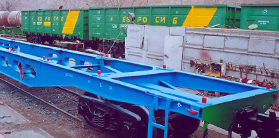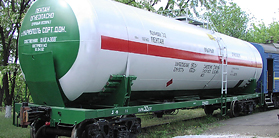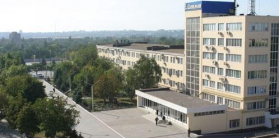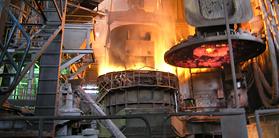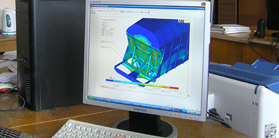Prehistory of car building in Mariupol began when on the 11th of March in 1945 the State Defense Committee of USSR made a decision about mastering the production of railway tank cars for oil and petroleum products transportation and made a resolution about the development of the designing bureau at the Works named after Ilyich.
In August 1945 the first 25 two-axle tank cars for transportation of oil and petroleum were manufactured and put into operation.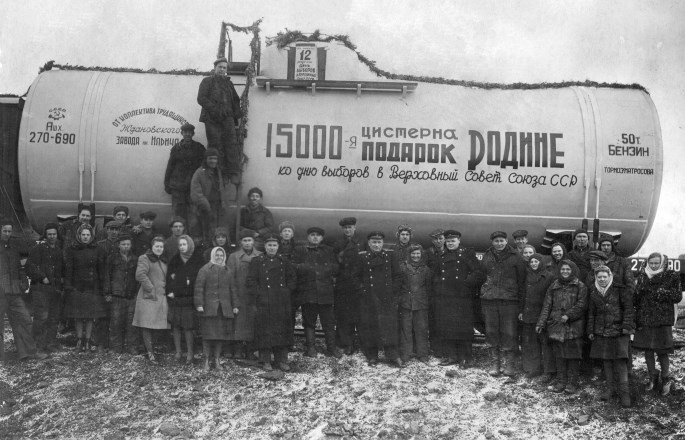
On the 12th of December 1948 the first four-axle tank car for blend with load carrying capacity of 50 ton was manufactured.
On the 3rd of February in 1949 the first four-axle tank cars for gasoline and spirit were produced. On the 17th of March in the same year the tank cars for light nitric acid were produced. On the 31st of August – the heat insulated tank cars for transportation of liquefied gases under pressure of 8 atm were manufactured.
Until 1948 all developments were performed by the technical department, since 1948 – by the special designing bureau, the chief designer of which was P.M. Khodos.
Thus, in 1956 the tank car for oil and petroleum on the platform with tank volume of 60m3 and without side channel beams was designed.
On the 8th of March 1958 by the Order of Council of Ministers of UkrSSR № 235 the self-dependent Heavy engineering machine building plant was separated from the Works named after Ilyich and the designing bureau of car building was merged into the Special designing bureau of the Heavy engineering machine building plant. The Chief Designer of it was P.M. Khodos, and L.S. Sigin and G.V. Lisin were his deputies.
In July 1959 the second designing bureau on car building headed by G.S. Ivchenko was organized.
In October 1959 those two designing bureaus on car building were incorporated into the newly established designing department of general machine building, the Chief Designers of which were S.A. Sokolov, Vashchuk, A.G. Milashich, V.M. Manov at different times.
On the 25th of May in 1961 the independent Department of the Chief Designer on CarBuilding (OGK VS) was founded at the Plant. P.M. Praha was appointed as its first Chief Designer and A.P. Kovriga became his deputy.
In 1961 the serial production of tank cars without conventional center girder with air-pneumatic-discharge for transportation of concrete and petroleum products was mastered.
In 1962 the tank car for petroleum products with load carrying capacity of 90 ton was designed, and in 1963 for the first time in the world practice the tank cars without conventional center girder and with load carrying capacity of 120 ton were designed.
Eight-axle tank car was developed in close cooperation with Moscow Institute of Railway Transport Engineers (MIIT).
If before 1965 the plant had been producing 16 types of tank cars, then by 1975 above 40 types of special-purpose tank cars were being manufactured. New tank cars with thermal insulation and electric heating were developed.
In 1968 the production of new four-axle tank cars for oil and petroleum products with tank volume of 73 m3 was mastered. These tank cars with some modifications have been produced up to now.
Within that period the tank cars for transportation of petroleum products, gases, acids, concrete, calcined soda, syrup and others are imported into Finland, Bulgaria, Mongolia, Cube in large quantities.
On the 26th of November 1971 the first batch of four-axle solid bottom open-top cars was manufactured.
In 1976 three prototype models of eight-axle tank cars for Baikal-Amur Mainline Railway were manufactured, on the 30th of September in 1976 the eight-axle frameless tank car for liquefied ammonia with load carrying capacity of 92 ton was produced.
In 1977 on the 16th of April the 250,000 in succession railway tank car was manufactured.
In August 1980 the prototype model of car of hopper type for transportation of powdered products was produced.
To the end of seventies the main nomenclature of railway tank cars had been formed including tank cars for petroleum products, liquefied gases (propane, ammonia, chlorine), acids (hydrochloric, sulphuric, nitric acids, oleum), loose goods (concrete, calcined soda, alumina, polyvinyl chloride), food products (spirit, milk, syrup, wine materials, fruit and vegetable juices), molten goods sulphur, sinter, naphthalene), toxic chemicals and others.
In eighties of the previous century the full modernization of the rolling stock began. Thus, there took place the change-over to roller bearings instead of sliding bearings in the bogies of freight cars; besides to manufacture the centre girders they began to use the strengthened Z-beam. Due to the increase of allowable axial load from 21 up to 23,5 t the technical parameters and specifications of the freight railway cars were changed. The new eight-axle tank car with the tank volume of 160 m3 was designed. The increase of freight carrying capacity was the principal task realized both in four-axle tank car for petroleum products and in eight-axle tank car.
At the end of eighties – at the beginning of nineties notwithstanding the external dramatic events “Azovmash” Concern (that was the name of the enterprise at that time) was establishing and mastering the new class of the transport vehicles – tank containers.
In 1996 the Designing Department of Tank containers building (KOKS) (headed by Chief Designer - V.S. Marinyuk and his deputy – E.K. Tusikov) was separated from the Designing Department of Car building (KOVS). The tank trucks for transportation of liquefied gases alongside with the installations for refueling automotive cars with liquefied gas were designed.
Till 1999 actually two enterprises “MZTM” and “Azovobschemash” legally independent were engaged in car building. The Designing department of car building was a part of Mariupol Scientific-Research Design-Engineering Technological Institute (MNIPKTI) which in its turn was a part of “MZTM” plant.
Lack of opportunities within the bounds of “MZTM” and the necessity to save the best engineering staff became the ground for establishment of CJSC “AzovVagonProekt - KOVS”. That decision was taken by the then General Director of OJSC “Azovmash” Savchuk Aleksandr Vladimirovich.
Alongside with CJSC “AzovVagonProekt-KOVS” there was Designing Department of Car Building (KOVS), which in that time was united with Designing Department of Tank containers building (KOKS).
Since December 1999 in connection with the appointment of A.V. Savchuk as the General Director of “MZTM” (Heavy Engineering Machine Building Plant) the structural reorganizations were started within the Engineering Services and Departments.
In 2000 the most significant developments were tank car for viscous petroleum products of 15-1710 type for Turkey and specialized box car of 200 m3 volume capacity.
At the end of 2000 the Designing Department of Car Building (KOVS) was incorporated into the Head Specialized Designing Technological Institute (GSKTI). At the same time there was taken a decision to unite KOVS and “AzovVagonProekt - KOVS” within GSKTI. The united structure was named the Specialized Designing Car Building Bureau (SKBVS).
In 2002 due to the special role of the car building branch in designing of new equipment the Specialized Designing Car Building Bureau (SKBVS) became an individual separate structure – the Head Specialized Designing Car Building Bureau (GSKBV).
The import of tank cars for petroleum products into Turkey had the particular significance.
In 2003 the hopper car for cooled coke of 22-1764 type was designed for OJSC “Azovstal”.
In 2004 the prototype model of the tank car for hydrocarbon gases of 15-1780 type with the tank volume of 85m3 was developed and tested. Open-top car of 12-1782 type was designed to be imported to Iran.
In 2005 tank cars for petroleum products of 15-1754 and 15-1755 types with maximum possible volumes according to the conditions of overall gabarits.
The significant achievement of 2005 was the designing of autorack car, the production of which was mastered in 2006.
The year of 2006 was laborious and productive one as well. In that year:
- the production of box car of 11-1807-01 type with the body volume capacity of 158 m3 was mastered;
- the open-top car for transportation of wood chips was designed and manufactured;
- the production of long flat cars for transportation of containers and pipes was mastered as well;
- the works on designing of draft gear of class Т1 were started.
In 2007 the new type of box car with heat insulation was designed and tested.
Besides in that year the new series of long flat cars (13-1796-03 and 13-1796-04 types) with higher stability to fatigue failure were designed.
Lately the freight bogie of 18-1750 type with axial load 23,5 ton designed on the basis of GSKBV drawings was recognized as one of the best in CIS countries.
Dozens of plants in Ukraine and Russia has been working with using the drawings of GSKBV.
The car model of 18-1711 (with axial load of 25 ton) is the basis for designing of the new generation of open-top cars and tank cars.
Hopper cars for transportation of grain and mineral fertilizers, new heat-insulated box car have been developed and certified alongside with coupled flat car, new tank cars for transportation of propane, chemical products and others; the insulated thermos-car has been modernized.
The name of Valeriy Mikhailovich Bubnov was assigned to the Head Specialized Designing Bureau on Car building in recognition of his services to the Enterprise and for his significant contribution into car building industry and in view of the 70th birthday of Valeriy Mikhailovich Bubnov, the General Designer – Director of GSKBV. V.M. Bubnov has been working at the Plant over 50 years. He is a Doctor of Engineering Sciences, Professor, the Associate Member of the Ukrainian and the InternationalEngineeringAcademies.
edits.txt
1112.docx


